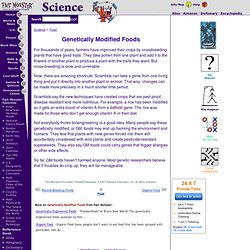

AR BookFinder US - Welcome. Team:British Columbia/humanpractices/GMOTimeline. The Truth Behind GE Foods. GE foods are patented inventions created primarily by six chemical companies (Monsanto, Dow, BASF, Bayer, Syngenta and DuPont).

Most GE crops were designed to make it easier to spray herbicides on growing crops, killing weeds but leaving the genetically transformed crops unharmed. Growing these crops has resulted in substantial increases in the use of herbicides and insecticides, frequently in amounts that have never been tested for safety in humans, animals or other plants. Overall pesticide use on the three major GE crops grown in the U.S. – corn, soybeans and cotton – increased by more than 527 million pounds from 1996 to 2011. Most of the increase resulted from growing reliance on the herbicide glyphosate, the key ingredient in Monsanto’s Roundup, the world’s best selling weed killer. The U.S. In the arms race between growers and weeds, moreover, the weeds have fought back, and 21 types have evolved to become resistant to glyphosate. History of GE Foods. (Via Food and Water Watch) 1992 – Calgene’s GE Flavr SavrTM tomatoes become first GE food on the market after approval by FDA. 1994 – Calgene’s GE canola approved by USDA. 1994 – Monsanto’s first Roundup Ready soybean approved by USDA. 1995 – Monsanto’s NewLeafTM potato, the first pest protected plant, approved by the EPA and FDA in 1995. 1996 – Monsanto’s first GE insect-resistant corn variety approved by USDA. 1997 – Calgene’s GE insect resistant Bt cotton approved by USDA. 1999 – GE papaya strains developed by Cornell University and the University of Hawaii approved by EPA. 2005 – Monsanto’s Roundup Ready alfalfa approved by USDA.

Organic Food. Genetically Modified Foods. For thousands of years, farmers have improved their crops by crossbreeding plants that have good traits.

They take pollen from one plant and add it to the flowers of another plant to produce a plant with the traits they want. But cross-breeding is slow and unreliable. Now, there are amazing shortcuts. Scientists can take a gene from one living thing and put it directly into another plant or animal. That way, changes can be made more precisely in a much shorter time period. Scientists say the new techniques have created crops that are pest-proof, disease resistant and more nutritious. Not everybody thinks bioengineering is a good idea. So far, GM foods haven't harmed anyone. Fact Monster/Information Please® Database, © 2007 Pearson Education, Inc. More on Genetically Modified Foods from Fact Monster: Genetically Engineered Foods - "Frankenfoods" or Brave New World?
How to Avoid Genetically Modified Foods. Nutrition Healthy Snack: Avocado Smoothie This potassium-rich smoothie from dietician Frances Largeman-Roth is the...

Alternative Health The Supplement Score Card Get alternative-health expert Bryce Wylde's bottom line on the supplements... What is a GMO? An introduction. How do I know which foods don’t contain GMO ingredients?

Products with the “USDA Organic” label are required by law not to use GMOs in their food production. Some companies also voluntarily label products as “non-GMO.” There is a current and voluntary system for retailers to designate GMO and organic produce. SKU Produce Look-Ups or PLUs that start with the number 8 designate GM produce and with the number 9 organic produce.
This system was developed by the Produce Marketing Association. Produce Marketing Association: Produce Identification Standards Produce Marketing Association FAQ International Federation for Produce Standards: FDA Food Labeling Guide What about the Flavr Savr Tomato? The Flavr Savr tomato was the first GMO product to be available commercially in the United States in 1994. Are there any fish genes in a tomato or other plant on the market today? That is fiction not fact. You might be thinking about research that a small biotech company did many decades ago. Top 10 Non-GMO Achievements of 2013. December 31, 2013 2013 was a year of great progress for the non-GMO movement.

Landmark efforts for mandatory labeling at home and abroad helped catapult the GMO issue into the mainstream, and consumer demand for non-GMO choices was off the charts. So much in fact, it was difficult to keep this list to just 10 items. Is there still work to be done? Absolutely!